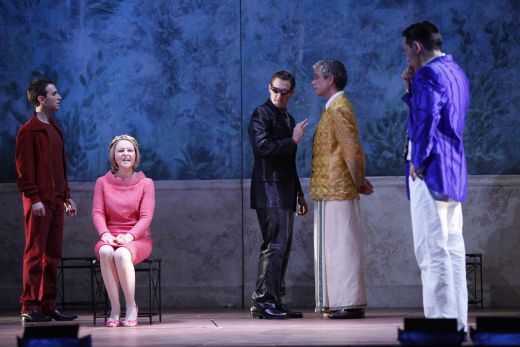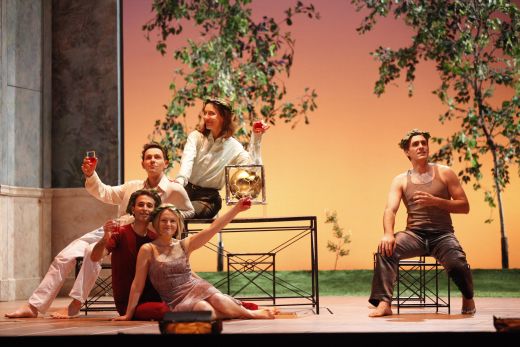Other Links
Editorial Board
- Editor - Bill Kenny
Assistant Webmaster -Stan Metzger - Founder - Len Mullenger
Google Site Search
SEEN AND HEARD INTERNATIONAL OPERA REVIEW
Production:
Conductor: Christian Curnyn
Production: Francisco Negrin
Stage Director: Andrew Chown
Set Designer: John Conklin
Costume Designer: Paul Steinberg
Lighting Designer: Robert Wierzel
Supertitles: Cori Ellison
Cast: Partenope: Cynthia Sieden
Rosmira: Stephanie Houtzeel
Arsace: Iestyn Davies
Armindo: Anthony Roth Constanzo
Emilio: Nicholas Coppolo
Ormonte: Daniel Mobbs

Anthony Roth Costanzo (Armindo), Cyndia Sieden (Partenope),
Nicholas Coppolo (Emilio), Daniel Mobbs (Ormonte), and Iestyn Davies (Arsace)
Perhaps the problem (if there really is a problem) lies in the kind of opera Handel had written. Lotario, the opera composed just before Partenope was not a success. A contemporary account stated that “everyone considers it a bad opera” and it closed after only nine performances. Handel, who was always looking for new ways to produce the next Broadway (read West End) blockbuster, decided to tone down the “seria” a bit and toned up the “buffa” side of his next opera Partenope. In fact, Partenope is neither opera seria nor opera buffa but rather a parody of both.
The plot revolves around the suitors of Queen Partenope. Who are the suitors? The better question is “Who isn't?” In an exaggerated parody of umpteen different Handel operas, Arsace is her first suitor, Armindo her second, and, finally Emilio, her warring enemy, is her third. Emilio commands the troops ready to battle Partenope's army but they are temporarily held back when Emilio glimpses Partenope from the distance: struck by her beauty, the belligerent Prince now wants love not war. The only two characters who are not lusting for the Queen are her tutor Ormonte and the betrayed Rosmira in a trouser role. Rosmira, dressed as the Prince Eurimene, appears out of nowhere in the first few minutes of the opera as if having a woman dressed as a man was de rigueur at the time. And who is Partenope in love with? Certainly Arsace, not so certainly Armindo, and for a few minutes Emilio.
In this production at least Queen Partenope seems quite the slut, groping every man she meets. The “battle” which ultimately takes place is performed in a parodic manner with Partenope dressed in a fencing outfit. As in many other baroque operas, there is the usual quick-fix ending: the self-centered Queen is willing, benevolently, to give up her previously stated, never-ending-love for Arsace for the sake of the betrayed Rosmira and becomes quite suddenly passionate about Armindo. Although everything in this opera ultimately succeeds, the feeling that something is missing might have to do with the unusual attempt to combine opera seria, opera buffa, and parody all at the same time.
Much has been made of the fact that the two women dominate and control the weaker men in this opera; at one point the women even slap their hands together in a high five, having accomplished their respective missions. But these women are far from being liberated. Rosmira acts more like a termagant, ultimately dominating the weak Arsace and Partenope, apparently driven by an inflated ego, ends up settling for her second choice, the emasculated Armindo.
The music, of course, is what makes the production live and breathe and there is much to admire here. Cyndia Sieden sang all the stratospheric arias with great ease, rarely straining for even the most difficult notes. Particularly appealing were her renditions of the Act I L'amor ed il destin and Sei mia gioia. Stephanie Houtzeel, as Rosmira sang Se non ti sai spiegar with great sensitivity. In one of the more imaginative staging moments Rosmira, dedicating her vows to the huntress Diana, sings Io seguo sol fiero to a skewered wild boar brought down from the rafters. Iestyn Davies's performance of the very difficult Furibondo spira il vento would have to be considered the opera's show stopper and his movingly sung Ch'io parta? was clearly Handel's source for the aria Ombra mai fù written eight years later for Serse. That opera, very similar in style and feel although with a slightly more substantive plot, shared Partenope's fate, closing after only five performances.

Clockwise: Stephanie Houtzeel (Rosmira), Iestyn Davies (Arsace),
Anthony Roth Costanzo (Armindo), Cyndia Sieden (Partenope), and Nicholas Coppolo (Emilio)
The staging although attractive was at times difficult to understand in relation to the plot: golden orbs and bowls containing lit candles
were carried on and off the stage without particular purpose. A neon lit square at the corner of the stage might
or might not represent a church or sanctuary and the he singers occasionally jump down a hole magically appearing center stage for no reason that I could see.
There were several minor changes to the original version of the opera, the most important being the replacement of the penultimate aria Si Scherza sì with an aria from Sosarme: Per le Porte del Tormento. I do question this change. Although the Playbill's Notes on Partenope claims
that doing this provides “a more satisfying denouement,” the text sounds more like something from the end of The Magic Flute than from Partenope:
Lovers' souls must pass
On there way to true joy
As a final note I would like to congratulate the New York City Opera for its changes to the theater seating, putting in two wide aisles and ridding the auditorium of the 50 or more seat rows. In the past you might have been required, if you were in an aisle seat, to get up 25 times or more to allow people to get to their seats.
Stan Metzger
Photos © Carol Rosegg
